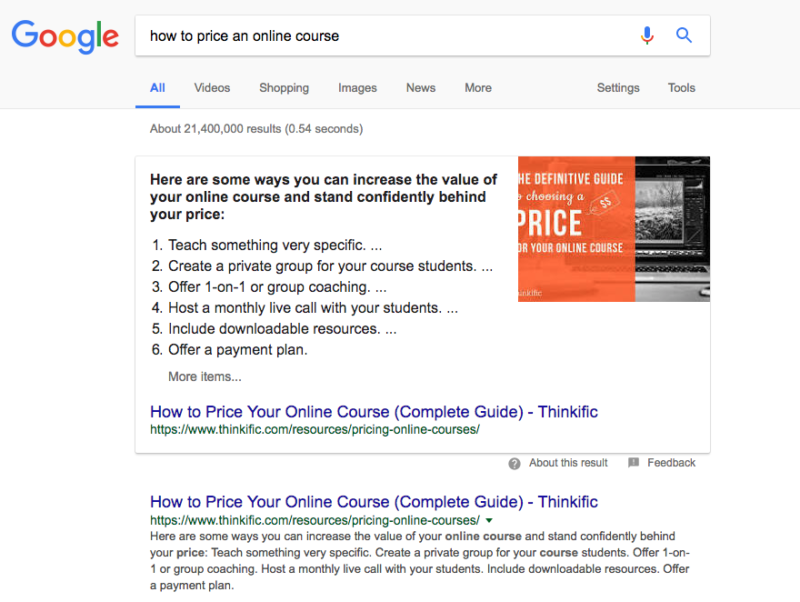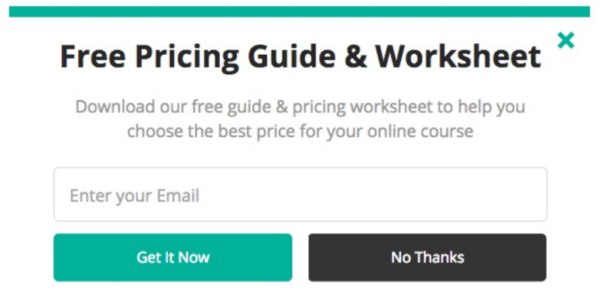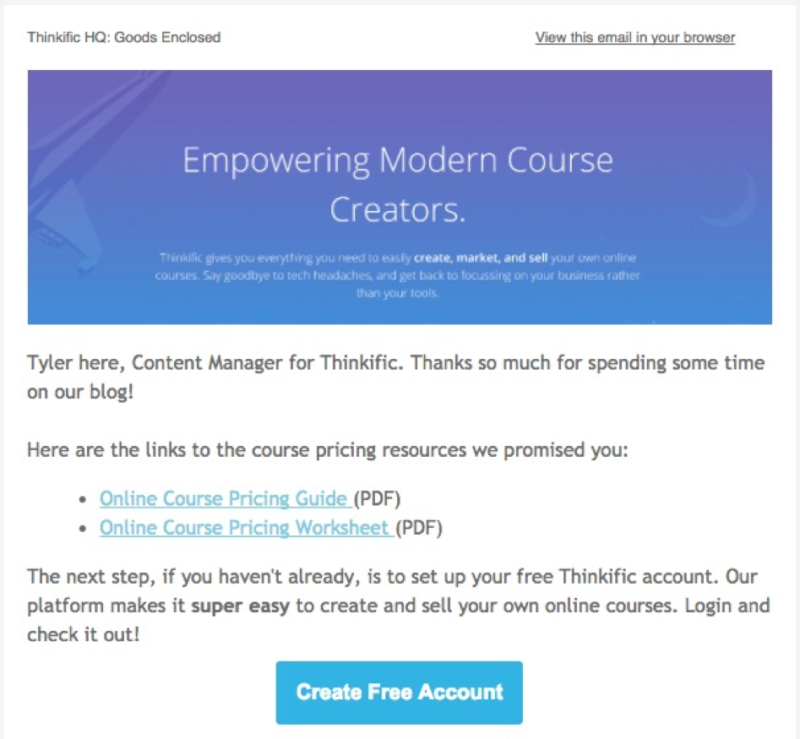
5 Steps To Convert Your Blog Readers Into Paying Customers
When I published my first blog post back in 2011, I had no idea if I would ever make money from my blog or if it could ever be profitable. This tends to be the case for a lot of people who start a blog.
At first, your goal might be to share our message, attract readers, and build your personal brand. Making money from your blog isn’t necessarily an immediate priority, but that can change the moment you have something to sell to your readers.
It wasn’t until I self-published a book on Amazon that I finally had my own product to sell, at which point I realized that every one of my blog’s readers suddenly became a potential customer for my book.
Since then, blogging (and more broadly, publishing content online – aka content marketing) has been my primary method of building an audience and attracting customers for various products and services – from books, to coaching/consulting services, online courses, and software.
While working as the Content Marketing Manager for Thinkific (a software platform for creating and selling online courses), my job was to create content that attracted and converted customers for their software. And since I was held accountable to contributing to the growth of the company, I was continuously evaluating and improving my process for creating and promoting content helped to attract new customers.
In this article, I’ll be sharing the 5 step process I relied on to convert blog readers into paying customers.
I’ve also included an example of a blog post I wrote for Thinkific – one that brought in several thousand emails subscribers and hundreds of new customers since it was published (without spending any money on advertising) – so you can see for yourself how effective these steps are when applied.
5 steps to convert blog readers into paying customers:
Step 1: Identify your ideal customer
Before you can write a blog post that attracts your ideal customer, you have to know who your ideal customer is.
This goes beyond just knowing their demographics (age, gender, income, etc.). Although demographics are a decent starting point, they don’t reveal why someone would buy your product or service.
Every product or service is a solution to a problem. Therefore, to create content that attracts your ideal customers, you need to first define the problem they are searching for a solution to. You need to understand your ideal customer in order to write a blog post that truly helps them.
Here are some questions to ask yourself:
- What do your favorite customers have in common?
- What challenges do they face that your product or service is a solution to?
- What goals do they have, and why haven’t they achieved them yet?
- Where do they currently go for information about your area of expertise?
- How do they describe the problem they are facing? What words do they use?
Once you have some clarity on who your ideal customer is, you’re ready to move on to the next step.
Step 2: Identify a topic that will help them
By writing an article that appeals specifically to your ideal customer (and no one else!), you help ensure that every person that reads your article has a higher likelihood of becoming a customer.
Unless your primary goal is brand awareness, don’t write articles for the general population. Write for a specific target audience – one that you actually want to do business with.
How to identify topics that will help your target audience:
Topics that are relevant to your target audience are revealed in their questions and complaints. Questions and complaints reveal pain points, and a blog post that addresses someone’s pain point is hard to resist to reading.
Here are a few places you can find out what your target audience is asking/complaining about:
- Quora
Type keywords related to your industry/expertise. Look for questions people are asking that directly relate to your area of expertise or product/service.
- Social media groups
Join groups on Facebook and LinkedIn related to your industry/expertise. Look for the most active conversations that are happening inside of these groups.
- Product reviews
Read the product reviews on Amazon or other online stores and marketplaces that your target audience buys from. Look for negative reviews on products that are similar to yours. Negative reviews reveal complaints, and complaints reveal opportunities.
- Customer support inquiries
If your company has a customer support team, spend some time reviewing the email inquiries and notes from calls with your customers. Look for frequently asked questions and challenges.
- Competitor blogs and content
Spend some time on the blogs and websites of your competitors. Look for blog posts that have a large number of comments and shares compared to other posts on the same site. These are signs of a winning topic. BuzzSumo is a great tool for this:

- Direct feedback from your customers/audience:
If you have an existing audience (email list, social media followers, etc.), then the best way to find out which topics they are interested in is to ask them! Send them a quick survey to ask them which topics they want to learn about.
How I used this process to choose a topic for Thinkific’s blog:
When I first started helping Thinkific with their content strategy back in 2016, one of my first steps was to put together a list of potential topics to write about on their blog.
By using the research methods listed above, I discovered a common challenge that Thinkific’s target audience (online course creators) faces: they don’t know how much to charge for their courses. I even found several questions about this topic posted on Quora:

After doing my research, I became confident that writing an article about online course pricing would not only help existing Thinkific customers, it would help to attract some new ones too. So I decided to write a blog post about pricing online courses.
Step 3: Write the best blog post you can about that topic
As you write your blog post, your goal should be to write the best article on the internet about your chosen topic. Gone are the days of getting mediocre content to the first page of Google. If you want your blog post to stand out from the competition, it has to be high quality. No exceptions.
Here are some tips for writing an epic blog post that search engines will love:
- Don’t hold back. Share your best advice (no fluff)
- Aim for at least 2,000 – 3,000 words (longer is even, just don’t sacrifice quality)
- Break up your post using sub-headers and bullet points for easy navigation
- Write short paragraphs (it’s a blog post, not a textbook)
- Include research or statistics from credible sources
- Include your own unique insights, stories, or examples
- Include quotes from experts you interviewed or surveyed
- Include screenshots or custom graphics to help support your points
How will you know if you wrote an epic blog post?
If your target audience doesn’t bookmark your blog post, comment on it or share it with others, it probably isn’t very epic.
Here’s a screenshot of a comment I received on my course pricing article. This is the kind of feedback you want from your readers:

If you write a truly epic blog post, then, in the long run, your post should outrank other blog posts about the same topic, which brings me to an important point:
Choose a primary keyword for your blog post
If you promote your blog post aggressively enough, it’s not hard to get your existing audience to read it. But if you want people who don’t know who you are yet to find it, then you need to optimize your post for search engine optimization (SEO).
The way to do this is to pick a primary keyword to target for your blog post. This will help to ensure that anyone who is searching for your chosen keyword will find your blog post in their search results.
If you have a Google AdWords account, you can use their Keyword Planner tool to pick a keyword based on monthly search volume. The best keywords to target are ones that have a high search volume and low competition. I recommend choosing a keyword that gets at least 1,000 searches per month.
If you run your blog on WordPress, I recommend using the Yoast SEO plugin to select your keyword and customize the title and description that appears in search results. This will tell search engines which keyword you want your blog post to rank for, and how it appears in search results.

Step 4: Add a content upgrade to build your email list
In the real world, the majority of the people that read your blog post will leave your website and never return to it again… unless you get their email address.
Once you’ve got someone’s email address, you have a lead. Turning a casual reader into a lead is a critical step in converting them into a paying customer.
Once someone is on your email list, you can communicate with them directly, continue to build a relationship with them, send them more helpful content over time, and ultimately, guide them through a sales process for your product or service.
Offer a free content upgrade in exchange for their email address
A content upgrade is a free resource that you essentially bribe your reader with in exchange for their email address. This can be additional training, a checklist, a worksheet, a summary, a free email course, etc. What’s important is that it compliments your blog post and is helpful for your reader.
By offering a content upgrade that you created specifically for your blog post, you immediately increase the conversion rate of your content upgrade.
For the course article, we offered a free course pricing guide and worksheet (PDF files). Here is a screenshot of the signup form we included in the blog post:

Step 5: Guide your email subscribers through a sales process
Once somebody is on your email list, the next step is to guide them through a sales process of some kind.
Depending on what you’re selling, the type of sales process you use will vary. The important thing is that you have a defined sales process – a specific step or series of steps that lead to giving them the opportunity to become a customer.
Here are some examples of commonly used methods for converting your email subscribers into paying customers:
- Invite them to a webinar where you present your product or service
- Send them directly to a sales page
- Offer a free consultation
- Offer a free trial
- Send them to an application page
- Offer them a special discount or coupon code
In the email I set up to deliver the content upgrade for the course pricing article, I included an invitation to sign up for Thinkific’s free plan. This gives them a risk-free way to start using the software before upgrading to a paid plan.

Optimize your conversion rates to maximize ROI
Once you’ve published a blog post that ties directly to a sales process for a specific product or service, the final step (sorry, I know I promised only 5 steps!) is to optimize your conversion rates to maximize your ROI.
Track the conversion rates from unique visitors to email subscribers, and email subscribers to paying customers. Once you have baseline conversion rates identified, test different changes to your process (different content upgrades, email subject lines, etc.) to help increase your conversion rates.
Small increases in conversion rates can result in big increases in revenue!
About the Author Tyler Basu
Tyler Basu is a Content Creator and Marketing Strategist that specializes in helping business owners create educational content to attract and retain more clients online.
Session expired
Please log in again. The login page will open in a new tab. After logging in you can close it and return to this page.

I think all your podcasts are great! The mixing up of solocasts and guests is great. Thank you for sharing your knowledge and being a wonderful source of encouragement and information to live the best, long life possible.
Thanks Ben, I really appreciate that feedback!
Really nice article about converting readers into customers. Hope i can make something from it!
Thanks Azhan, I’m glad this was helpful for you!
[…] Readers Into Paying Clients (How to Build a Profitable Blog)’. Tyler Basu [online] Available at: https://tylerbasu.com/profitable-blog-readers-into-clients/ [Accessed 10 May […]
it seems obvious, but many people are shy about self-promotion.
But really – your readers won’t know what you want them to do unless you ask them!
If you’re blogging with a goal in mind, it’s crucial to include some kind of call to action (CTA) on your blog.
That doesn’t mean ending every post with “Thanks for reading, now buy my product!”
Using a variety of CTAs can help you to deepen your relationship with your readers, keeping them coming back for more content and eventually turning into customers.
You can also use CTAs to encourage readers to comment, share the post with friends, follow you on social media, etc. These are great tactics for engaging loyal readers and building your audience.
But in order to convert that audience into customers, you eventually need to ask them to buy!
Post a high quality content in your blog is the first step for making your website your sales instrument. Completely agree here. Then all you described – promotion through email marketing, social meda and sharing wherever is possible to get more traffic and raise interest. And I believe control of your customer support system is important as well. Unfortunately, if you don’t monitor your website chat or SM messages or your call center doesn’t work in the proper way, it’s pretty much possible that clients will leave on this step. This is very important to build well functioning sales funnel. Thank so much for all your tips!!
[…] 5 Steps to Turn Blog Readers Into Paying Clients (How to Build a Profitable Blog) […]
Thanks Tyler, I am struggle to turn readers into paying customers so this is exactly what I was searching for.
No problem, I’m glad this was helpful for you!
[…] inexpensive to start and easy to maintain. In addition, they can be extremely effective in attracting new customers to your brand and maintaining your current customer base. However, one drawback to this method is […]
Once you’ve published a blog post that ties directly to a sales process for a specific product or service, the final step (sorry, I know I promised only 5 steps!) is to optimize your conversion rates to maximize your ROI.
Turn blog readers into paying customers with these five crucial steps. From engaging content to a seamless user journey, optimize your blog for conversions. Capture interest, build trust, and effortlessly guide your audience towards becoming loyal customers.
Converting blog readers into paying customers is a crucial aspect of building a successful online presence. Your guide on the 5 steps to achieve this is incredibly helpful. Understanding your audience, providing valuable content, and incorporating persuasive calls-to-action are all essential strategies. Implementing these steps can undoubtedly lead to increased conversions and revenue. For those looking to take their online business to the next level, this resource is a must-read.